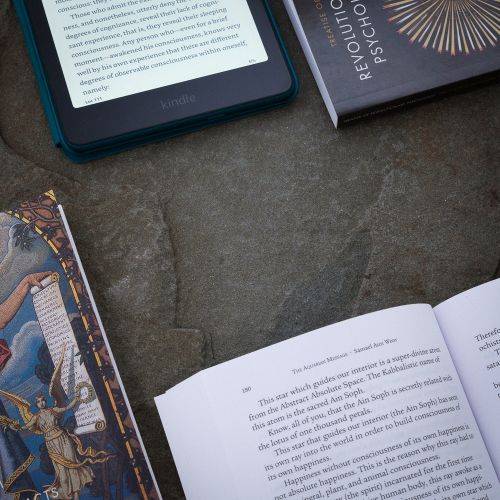The sanctuary of Hercules (the Christ) that gloriously shone in submerged Atlantis was a resplendent companion to the marvelous Temple of Jagrenat (of whose many marvels A. Snider wrote in the formidable work entitled La Création et ses mystères dévoilés).
Those were unforgettable times of profound poetry when King Evander eloquently explained to Aeneas, the eminent Trojan man, all the delectable enchantments of the sacred banquet offered in honor of Hercules.
If the god Vulcan (the Third Logos) truly deserves abundant praise, then what would we say of the Lord, the Christ, the Second Logos, Hercules?
The chorus of young warriors sang in the sacred banquet, hymning praise to the lord (Hercules) and his great deeds, enumerating with exceptional beauty the way he endured all of his labors.
When he was still a child, Hercules seized and throttled the poisonous snakes, which were the first monsters sent against his life. (Let us remember King Herod and the slaying of all the innocent children).
Hercules slaughtered the Lernaean Hydra, that is to say, the tempting serpent of Eden, the horrifying viper from the sinister temple of the goddess Kali.
With the sacred fire, Hercules cleaned the stables of Augeas, that is to say, the forty-nine subconscious regions of the human mind, where all of the beasts of desire horrifyingly abide.
Hercules killed the huge lion of Nemea, that is to say, he eliminated or extinguished the Luciferic fire, and also dragged Cerberus, the infernal watchdog of Orcus (the sexual instinct) from the darkness into the light. Hercules is certainly admirable, and worthy of all praise and glory.
To think, oh God, that Hercules repeats his labors each time he comes into the world is terrific... grandiose...!
It is clear, and by all means evident, that in order to incarnate Hercules within ourselves, we must first work in the flaming forge of Vulcan (sex).
“Woe to the Samson of the Kabbalah if he permits himself to be put asleep by Delilah! The Hercules of science, who exchanges his royal sceptre for the distaff of Omphale, will soon experience the vengeance of Dejanira, and nothing will be left for him but the pyre of Mount Oeta, in order to escape the devouring folds of the tunic of Nessus.”
From the heights of the Tarpeian Rock, all of those who betray Hercules are precipitated into the bottom of the abyss.
There, in those times of the submerged Atlantis, the temple of Hercules was erected upon a rocky boulder.
The extraordinary and marmoreal stone that gave access to the temple, and its cyclopean and imposing mass, truly made this sanctuary like a precious twin brother to the Temple of Philae in Upper Egypt, and to other many venerated Mayan, Nahua, and Aztec sanctuaries.
If we think at least for a moment of the City of the Gods (Teotihuacan, Mexico), and of the secret paths and subterranean crypts of that sacred place (ignored by tourists), then we must not ever forget the colossal constructions beneath the temple of Hercules.
Certainly, beneath the facade of the temple opened a royal portico that had twelve statues of zodiacal gods. These clearly symbolized the twelve faculties of the human being, and the twelve saviors of whom the great Kabir Jesus so wisely spoke.
Ancient traditions state that this portico was similar to the celebrated House of the Dwarf, also called the House of the Magi, Great Teocalli or the House of God, in Mexico.
The initiates reverently and timorously entered under that terrific portico and passed beneath the columns of Hercules.
Such columns were of pure gold, and upon them were engraved the words Adam Kadmon with sacred characters. The M.M. know very well about the “J” and “B,” plus ultra.
Seven auric steps upon which the initiate descended led him to a rectangular precinct.
That mysterious place was found vested wholly with pure gold, and corresponded exactly to the superior hall that was always open to the supplications of the profane world.
This was the Chamber of the Sun, but four other chambers existed, and the mysteries shone in all of them.
The second crypt was ineffable. Five descending flights of silvery tin, the sacred metal of Brihaspati, Jupiter, or IO, reached down into it.
The planets Mars and Venus shone in the third crypt. The red coloration of one and the foamy white of the other gave to that environment a pink and very beautiful tint.
Of the seven solar palaces, the third one in Christian and Jewish Kabbalah is related to Lucifer / Venus, which makes it the abode of Samael.
The occidental, allegorical Titans are in themselves also intimately related with Lucifer / Venus.
Thus, Sukra, in other words, the regent of the planet Venus, is the one who incarnated on the Earth as Usanas, and is known in Hebrew as Uriel. He gave perfect laws to the inhabitants of this world. Disgracefully, in later ages these perfect laws were disregarded and rejected.
I knew Usanas / Uriel on the polar continent during the first root race. He wrote a precious book with runic characters.
Lucifer is the fatal, negative aspect of Venus. Venus always shines at dawn, but the Luciferic forces are terribly agitated at dawn.
Venus is truly the elder brother, the messenger of the light for the Earth, in the physical as well as the mystical sense.
Saturn and the Moon glowed face to face upon the altar, always shining in the fourth initiatic chamber of the temple of Hercules.
It is urgent to remember that the two paths of the Atlantean epoch, the dexterous and the sinister, were clearly shown, and their struggles of more than 800,000 years are symbolically sung in that oriental poem of the great war, The Mahabharata.
So, by descending a little more, the Atlantean initiates entered into the fifth crypt, the one of Hermes, or Mercury, who splendidly glittered upon the altar.
Mercury, as an astrological planet, is the nuncio and wolf of the Sun, Solaris Luminis Particeps. Mercury is the chief and evoker of souls, the arch-magi and arch-hierophant.
The unhappy souls who are precipitated into the Orcus (Limbo) can be summoned to a new life by Mercury, who holds in his dexterous hand the caduceus or hammer with two serpents. “Tun virgam capit: hac animas ille evocat orco,” [“Then he takes his wand: with this that one calls out the pale spirits from Orcus” - Aeneid IV:242] in order to initiate them into the celestial militia...
Remember that within Limbo live many saints, wise men, and sweet maidens who believed in achieving the inner Self-realization of the Being without Sexual Magic. Poor souls... they did not work in the forge of the Cyclops, they did not build the solar bodies, the wedding garment of the soul.
Blessed be the one who integrally comprehends the wisdom of the five crypts of the temple of Hercules.







